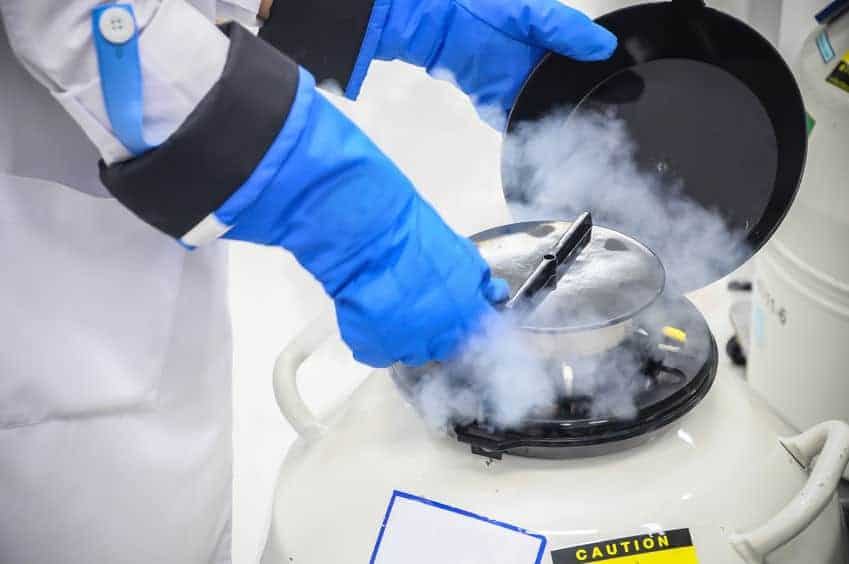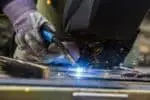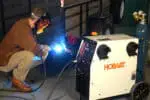Gases irrespective of their uses play a major part in the creation of a good weld. Nitrogen is one of the gases used in welding, and gets attention from welders but not as much as helium or argon.
In fact, at times the question of whether nitrogen can be used for MIG welding pops up in curious minds.
Yes, nitrogen can be used for MIG welding. This semi-inert gas adds certain good qualities to the weld when used as a shielding gas or in other forms. However, there is a negative side to the same as well. Through a few subjects, I am going to tell you everything you need to know about the topic.
Through a few subjects, I am going to tell you everything you need to know about the topic.
How does nitrogen help in MIG welding?
Nitrogen is one of the most abundant gases found in nature. Being non-reactive in nature, nitrogen serves the purpose of staying in its true form while dealing with intensive welding procedures almost similar to how Argon works. Often used in mixtures with other gases, nitrogen enhances the procedure smoothness in the following ways:
1. Improves arc stability: Nitrogen enhances the arc stability thereby helping in a spatter-less welding process. The better the arc stability, the lesser will be the mess created. As a result, the effort put into post-welding cleanup can be reduced.
2. Enables a good penetration: Along with arc stability, nitrogen is known for its ability to ensure good penetration. Usually mixed with gases like helium and argon, nitrogen helps to transfer enough heat to the metal making penetration easier.
3. Prevents oxidation of the metal: At intense heat, metals melt and tend to oxidize. Being non-reactive in nature, nitrogen helps to prevent this from happening.
4. Ensures good corrosion resistance: Nitrogen when added with argon as shielding gas mixture, will increase the corrosion resistance properties of the metal thereby giving durability to the life of the metal.
5. Improves metal’s mechanical properties: The presence of the particular gas also add to the tensile strength of the metal especially in the case of stainless steel.
See also: Which is the Best Gas to MIG Weld Mild Steel?
When does Nitrogen become an essential element in MIG welding?
Apart from the benefits that nitrogen offers for the betterment of procedures, it becomes an essential gas to be included in the procedure in certain particular situations.
Nitrogen is the perfect choice to be included in the gas mixture when you are going for alloys containing nitrogen in them. Yes, you heard that right. Wonder why it is so?
Nitrogen in metals tends to leach when heated. When welding requires the metal to be heated to a high temperature, alloys can often showcase this characteristic resulting in the degradation of the quality of the metal. To prevent this shielding gases are used. In this case, nitrogen will serve the purpose perfectly.
What are the different applications of nitrogen in MIG welding?
Nitrogen does not carry its responsibility as an enhancer of welding in one form. It rather comes to the rescue in different ways as follows:
1.) Shielding gas: I have already mentioned how nitrogen works as an excellent shielding gas by keeping the metal from getting oxidized. Oftentimes, they are used in mixtures for they are good enhancers of gas qualities.
Unless the metal is flux-cored, a shielding gas is necessary for welding. When used these gases keep the metal free from bubbles and take on an unattractive nature.
2.) Purging gas: Nitrogen can also be used as a purging gas in MIG welding especially for works involving stainless steel. Purging gases are used to cover the bottom part of the metal.
The top part will be sealed off leaving the bottom part exposed for the gas to be applied. Unlike the normal shielding, this is done separately from the welding procedures.
3.) Heating gas: Normally done before welding, it preheats the metals ready to make them welded. The better the heating effect, the better will be the weldability. Except for carbon steel, nitrogen can be mixed with other noble gases for nitrogen-rich metals.
How effective is nitrogen as a purging gas in MIG welding if replaced with argon?
The question of whether nitrogen can be used to replace argon is quite common. Unlike argon, nitrogen is not a complete noble gas. Being a semi-inert gas it has its limitations when it comes to MIG welding.
Often, therefore, argon is never replaced with nitrogen, rather is used as a purging help giving support to the inert characteristics and excellent heating properties of argon.
As nitrogen is non-combustible and dry, the presence of the gas will also ensure that the atmosphere is safe for the intense procedure.
What about GTAW welding?
However, For TIG welding, replacing argon with nitrogen as purging gas is more doable. Based on a credible experiment, it was proved that in terms of mechanical properties, chemical characteristics of the roots of the weld, microstructural variation, and corrosion resistance, nitrogen as the purging gas came out to be a good replacement for argon.
The metal used for study here was Austenitic Stainless Steel and the only thing to be heeded was to weld is not a high temperature. To get a detailed report on the same visit this link
http://files.aws.org/wj/supplement/WJ_1975_01_s12.pdf
Nitrogen is used as a replacement for argon only when cost matters as nitrogen is cheaper than argon.
When does nitrogen become a problem in MIG welding?
If used in a high amount, nitrogen is said to affect the quality of the weld. Especially in the case of MIG welding stainless steel, even when nitrogen is used to bring out the best result in terms of bead profile and quality of the weld, a slight change in proportion added can result in drastic changes.
As nitrogen is slightly reactive in nature, it can cause detrimental effects in arc welding resulting in welds that might not be up to the standard you root for.
Is nitrogen the best gas for MIG welding?
No, nitrogen due to the limitations of its characteristics is not considered the best gas to be used for MIG welding. In fact, nitrogen is only used in MIG gas mixtures and never solely. So what is the best gas, you ask?
The answer is also a mixture. The combination of Carbon dioxide and Argon is considered as the top combination to be used in MIG welding. Usually, it goes in the ratio of 75/25 (Argon: CO2). Carbon Dioxide is a “semi-inert” gas and is known for its capability to ensure good penetration.
This combination is particularly useful for welding mild steel. This mixture is ideal as it is cost-effective and suitable for welding most metals.
To wrap up
Nitrogen is a good choice for MIG welding as an enhancer of other gases’ qualities. When used in the optimal quality it can give excellent results and aesthetic welds.
Make sure to use it for the right metals that require the presence of nitrogen to bring out the best welds possible in them.
That is all for today.
See you in another interesting blog post!






